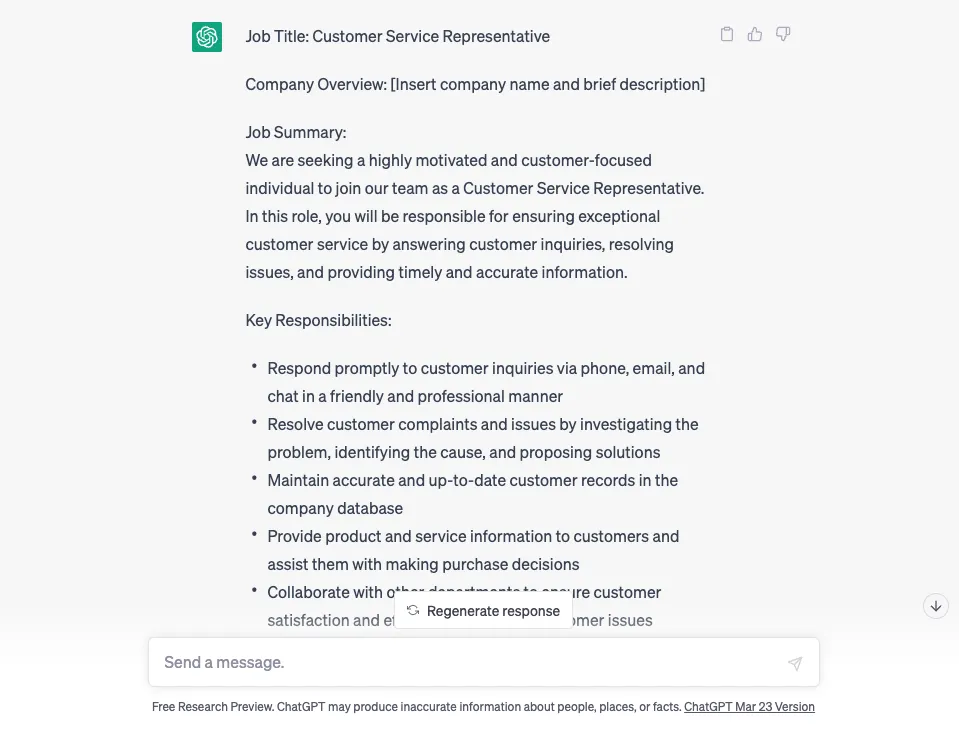Table of contents
How to use ChatGPT
ChatGPT, and other AI language generators, are changing the game when it comes to creating content. From essays to articles to emails, ChatGPT can write short- and long-form copy in seconds. But using AI powered chats to create engaging, accurate and original writing is another story. Let’s take a look at how to use ChatGPT to support your writing, not write instead of you.
Create a ChatGPT account
ChatGPT is an artificial intelligence (AI) chat that has access to multitudes of online content and generates information-rich responses in conversational style. Read What is ChatGPT if you haven’t already and get across this essential new technology.
Creating a ChatGPT account is easy. Sign up using your email here. You’ll be taken to a chat interface which feels similar to the good old days of MSN (for Millennials, that is!).

Create a ‘New chat’ on the left hand side of the portal, and enter your question into the window running along the bottom of the page. Continue the chat by asking the AI for more information or clarification, creating a two way dialogue.
You can create a new chat to explore a different topic, and each chat will be saved along the left hand side for future reference as required. Say you’re looking for a customer service representative – you can use ChatGPT to learn tips for writing a good job description, or have it write one for you!

Support your writing with ChatGPT
As you can see, a tool that aggregates and summarises all available information can be a little dry. ChatGPT tends to return very generalised and repetitive language. When using the chat to write content, it’s the job of the human writer to bring cultural understanding, emotion and relevant examples to the piece, whether it’s a job description or a short story, to engage the reader.
Say you want to write a blog article about the benefits of doing mindfulness meditation at work. Here are some ways to use ChatGPT as a support tool, rather than letting it write for you:
- Ask ChatGPT for ideas – eg. come up with 5 ideas for articles about the benefits mindfulness meditation at work
- Ask for key events in history of mindfulness meditation to give your work more context
- Paraphrase dense text – there’s lots of information our there, see how you can break it down
- Ask to expand on points you find interesting in your research
- Generate headlines for news articles – different phrasing helps you think of different angles for a story
- Ask for outlines for a blog article about meditation at work – ChatGPT can help you organise thoughts, create structures and pull out key points
- Fact check your work by asking ChatGPT for sources to support claims about the benefits of meditation
- Notice words you’re repeating and ask ChatGPT for synonyms
- Ask Chat GPT to edit your copy
What to be aware of when using ChatGPT
As well as nuance, considering the accuracy of information is critical in publishing content generated by AI chats. ChatGPT is merely collating data and regurgitating it for ease of use, and we all know how much fake news there is out there. That’s why it’s important to validate the claims you’re generating with ChatGPT with reputable sources.
Copyright is another consideration that is stumping ethicists and lawyers about AI language generators. Firstly, bots are fed information to ‘learn’ and have data to draw from when prompted. Authors aren’t necessarily being asked permission for their work to be used in such a way. Secondly, the output of the bot may contain content that is in fact copyright, ie not allowed to be reproduced without consent. In these infringements, it’s unclear whether the creators of the bot or the user of the bot (us in this case!) is responsible for copying or plagiarising the work.
Such questions will be answered only as the technology develops and becomes more widely used. Until then, it’s best practice to diversify your sources and write original work.
Check your content is human-centric
At the end of the day, you’re writing to connect with your reader, whether they’re a potential new employee or you’re trying to change someone’s mind in an opinion piece. Questions to ask yourself when you’re writing content with the help of ChatGPT:
- Is your content useful to your audience?
- Are you bringing life to your point with nuance and emotion?
- Is the content substantial, with references, ideas, examples and context?
To stay ahead and learn about the technology, which is quickly evolving, head to OpenAI.com to read more about how ChatGPT works.
![]()











